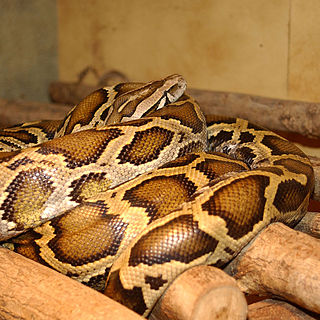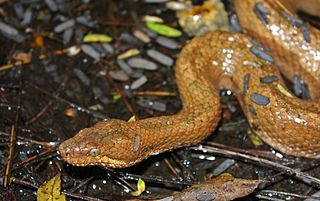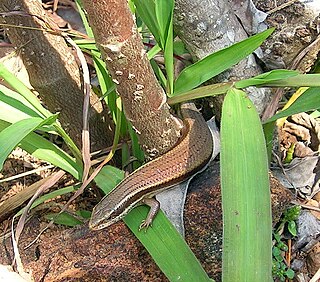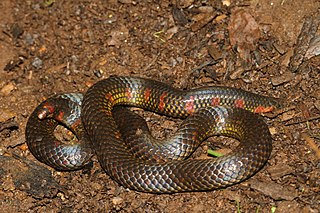
The Boidae, commonly known as boas or boids, are a family of nonvenomous snakes primarily found in the Americas, as well as Africa, Europe, Asia, and some Pacific islands. Boas include some of the world's largest snakes, with the green anaconda of South America being the heaviest and second-longest snake known; in general, adults are medium to large in size, with females usually larger than the males. Six subfamilies comprising 15 genera and 54 species are currently recognized.

Squamata is the largest order of reptiles, comprising lizards, snakes, and amphisbaenians, which are collectively known as squamates or scaled reptiles. With over 10,900 species, it is also the second-largest order of extant (living) vertebrates, after the perciform fish. Members of the order are distinguished by their skins, which bear horny scales or shields, and must periodically engage in molting. They also possess movable quadrate bones, making possible movement of the upper jaw relative to the neurocranium. This is particularly visible in snakes, which are able to open their mouths very wide to accommodate comparatively large prey. Squamates are the most variably sized living reptiles, ranging from the 16 mm (0.63 in) dwarf gecko to the 6.5 m (21 ft) Reticulated python. The now-extinct mosasaurs reached lengths over 14 m (46 ft).

Boa is a genus of non-venomous boas found in Mexico, the Caribbean, and Central and South America. Five extant species, and one extinct, are currently recognized.

The Caenophidia are a derived clade of alethinophidian snakes, which contains over 80% of all the extant species of snakes. The largest family is Colubridae, but it also includes at least seven other families, at least four of which were once classified as "Colubridae" before molecular phylogenetics helped us understand their relationships. It has been found to be monophyletic.

Loxocemus bicolor,the sole member of the monotypic family Loxocemidae, is a species of python-like snake found in Mexico and Central America. No subspecies are currently recognized. Analyses of DNA show that Loxocemus is most closely related to the true pythons and the sunbeam snakes.

Xenopeltis, the sunbeam snakes, are the sole genus of the monotypic family Xenopeltidae, the species of which are found in Southeast Asia. Sunbeam snakes are known for their highly iridescent scales. Three species are recognized, each one with no subspecies. Studies of DNA suggest that the xenopeltids are most closely related to the Mexican burrowing python and to the true pythons (Pythonidae).

Henophidia is a former superfamily of the suborder Serpentes (snakes) that contains boas, pythons and numerous other less-well-known snakes.

The Cylindrophiidae are a monotypic family of secretive, semifossorial, non-venomous snakes containing the genus Cylindrophis found in southeastern Asia. These are burrowing snakes and most have a banded pattern on the belly. Currently, 13 species are recognized, all with no subspecies. Common names include Asian pipe snakes or Asian cylinder snakes.

The Tropidophiidae, common name dwarf boas or thunder snakes, are a family of nonvenomous snakes found from Mexico and the West Indies south to southeastern Brazil. These are small to medium-sized fossorial snakes, some with beautiful and striking color patterns. Currently, two living genera, containing 34 species, are recognized. Two other genera were once considered to be tropidophiids but are now known to be more closely related to the boids, and are classified in the subfamily Ungaliophiinae. There are a relatively large number of fossil snakes that have been described as tropidophiids, but which of these are more closely related to Tropidophis and Trachyboa and which are more closely related to Ungaliophis and Exiliboa is unknown.

The Boinae are a purported subfamily of boas found in Central and South America, as well as the West Indies. In the Integrated Taxonomic Information System (ITIS), Boinae is considered an invalid synonym of Boidae.

The Alethinophidia are an infraorder of snakes that includes all snakes other than blind snakes and thread snakes. Snakes have long been grouped into families within Alethinophidia based on their morphology, especially that of their teeth. More modern phylogenetic hypotheses using genetic data support the recognition of 19 extant families, although the taxonomy of alethinophidian snakes has long been debated, and ultimately the decision whether to assign a particular clade to a particular Linnaean rank is arbitrary.
The Pythonoidea, also known as pythonoid snakes, are a superfamily of snakes that contains pythons and other closely related python-like snakes. As of 2022, Pythonoidea contains 39 species, including the eponymous genus Python and 10 other genera of pythons, all in the family Pythonidae, as well as two lesser-known families, Loxocemidae and Xenopeltidae.

Lygosominae is the largest subfamily of skinks in the family Scincidae. The subfamily can be divided into a number of genus groups. If the rarely used taxonomic rank of infrafamily is employed, the genus groups would be designated as such, but such a move would require a formal description according to the ICZN standards.

Malayopython is a genus of constricting snakes in the family Pythonidae. The genus is native to India and Southeast Asia. It contains two species, both of which were previously classified within the genus Python. However, multiple studies recovered these species as distinct. Known as the "reticulatus clade", it was eventually found to be a sister lineage to a lineage giving rise to the Indo-Australian pythons rather than the genus Python.

The Booidea, also known as booid snakes, are a superfamily of snakes that contains boas and other closely related boa-like snakes. As of 2017, Booidea contains 61 species, including the eponymous neotropical Boa constrictor, anacondas, and smaller tree and rainbow boas as well as several genera of booid snakes from various locations around the world: bevel-nosed boas or keel-scaled boas (Candoia) from New Guinea and Melanesia, Old World sand boas (Eryx) from Northeast Africa, the Middle East, and Southwest Asia, rubber boas (Charina) and rosy boas (Lichanura) from North America, neotropical dwarf boas (Ungaliophis) and the Oaxacan dwarf boa (Exiliboa) from Central America, Madagascan boas or Malagasy boas from Madagascar, and the Calabar python (Calabaria) from tropical West-Central Africa.

The Uropeltoidea, also known as uropeltoid snakes, are a superfamily of snakes that contains uropeltids and Asian pipesnakes.

The Amerophidia, also known as amerophidian snakes, are a superfamily of snakes that contains two families: Aniliidae and the boa-like Tropidophiidae.

The Colubroides are a clade in the suborder Serpentes (snakes). It contains over 85% of all the extant species of snakes. The largest family is Colubridae, but it also includes at least six other families, at least four of which were once classified as "Colubridae" before molecular phylogenetics helped in understanding their relationships. It has been found to be monophyletic.

Afrophidia is a clade of alethinophidian snakes comprising the groups Henophidia and Caenophidia, essentially making up the snakes people commonly associate with. The name refers to the deep split between Afrophidia and their sister taxon, Amerophidia, which originated in South American origin, and the afrophidians was recently hypothesized to represent a vicariant event of the breakup of Gondwanan South America and Africa.














